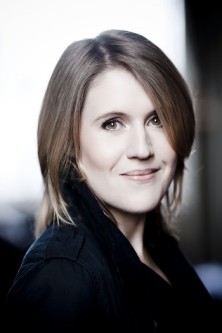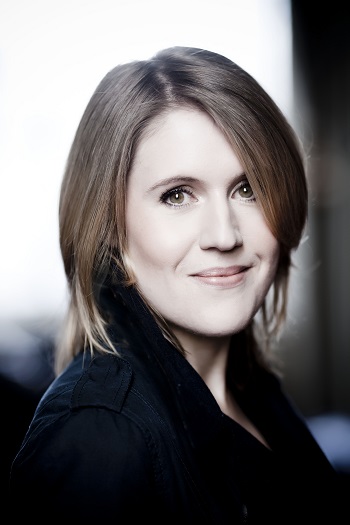 Switzerland Various: Anna Stéphany (mezzo soprano), Labyrinth Ensemble, Opernhaus Zürich, 4.4.2016. (RP)
Switzerland Various: Anna Stéphany (mezzo soprano), Labyrinth Ensemble, Opernhaus Zürich, 4.4.2016. (RP)

Falla: “Psyché” for Voice, Flute, Harp & String Trio (1924)
Honegger: “Chanson de Ronsard” for Voice, Flute & String Quartet (1924)
Caplet: “Les Prières” for Voice, Harp & String Quartet (1922)
Ravel: “Introduction et Allegro” for Harp, Flute, Clarinet & String Quartet (1906) ; “Histoires naturelles” (1906), arr. for Mezzo Soprano & Small Ensemble by Arthur Lavandier (World Premiere)
Debussy: “Rhapsodie” (1909/10), arr. for Clarinet & Small Ensemble by David Walter
Berio: Folk Songs (1964)
Labyrinth Ensemble – Hanna Weinmeister & Anahit Kurtikyan (violins), Sebastian Eyb (viola), Claudius Herrmann (cello), Julie Palloc (harp), Pamela Stahel (flute), Robert Pickup (clarinet), Clément Noël (oboe) and Hans Peter Achberger & Michael Guntern (percussion)
Anna Stéphany graces a stage with charm and poise. Her alluring mezzo soprano voice is effortlessly produced, and her phrasing and sensitivity to text is exceptional. For this concert, she shared the stage with the Labyrinth Ensemble, all members of the Zurich Opera’s orchestra. I have often been enthralled by their playing over the years, so it was a privilege to hear these fine musicians in a completely different musical genre. The program featured music from the early 20th century by French, Spanish and Swiss composers, and a radical Italian one who was active a few decades later. One seldom encounters works of this sort in the recital hall, let along an entire evening of them. I do not want to bore the reader, and frankly my vocabulary is not that rich, so I will just simply state that this concert was absolutely beautiful. Nothing more needs to be said, except for some insights into the music which was performed.
The first three pieces on the program were all French in spirit, regardless of the nationality of the composer, and featured Stéphany with different instrumental groupings. Manuel de Falla’s “Psyché,” which he imagined being performed for 18th-century Spanish royalty in a room of the Alhambra Palace, opened the concert. The introduction, played by the instruments alone, features a Debussy-like melody for the flute, followed by the voice entering a cappella to sing of the tragic fate of the Greek goddess who fell in love with Cupid. Next was Arthur Honegger’s “Chanson de Ronsard,” composed in the same year, which tells of an all-consuming, unrequited love. André Caplet, the least well known composer on the program (Honegger’s face is on the Swiss twenty franc note), was a friend of Claude Debussy and a noted conductor in his day. “Les Prières,” composed during the First World War, are settings of The Lord’s Prayer, Ave Maria and the Apostles’ Creed. These are profound settings, clearly a reaction to the horrors of the war.Maurice Ravel’s “Introduction et Allegro” was the first of two works that the ensemble played on its own. Ravel composed the piece in only eight days for the traditional pedal harp (commissioned by its manufacturer), in direct response to Debussy’s “Danses sacrée et profane,” which explored the potential of the then new chromatic harp. Although the work has delightful melodies for the woodwinds and shimmering string passages, it is naturally the harp that predominates. Julie Palloc’s playing was brilliant. The second was an arrangement of Debussy’s “Rhapsodie” for clarinet and small ensemble by David Walter, a French oboist, conductor and composer. Debussy said of the piece that it was “one of the most charming I have ever written.” He might well have omitted the qualifier if he had heard Robert Pickup play the solo part.
Do we have real controversies any more in classical musical circles, except for those arising from directorial liberties in opera productions? Listening to Maurice Ravel’s “Histoires naturelles,” one only delights in the humor and charm of the five songs about four birds and an insect. At their premiere, however, they were controversial, in part due to the naturalistic, almost naive description of the creatures, as well as Ravel’s setting of actual text, as opposed to poetry. This was the first performance of an arrangement of the song cycle for small ensemble by Arthur Lavandier, commissioned by the Labyrinth Ensemble. Ravel himself orchestrated the songs, originally conceived for voice and piano. Lavandier, a prize winning French composer and arranger, put his individual stamp on them. “Le cygne” (swan) was particularly memorable for the glimmering sounds created by finger cymbals, triangle, harp and strings. In the final song, “Le pintade” (guinea fowl), the tambourine suggested the ungainly bird’s antics, and a squawk from the clarinet and oboe its shrill cry.
I hope that no one stayed home upon seeing the name Luciano Berio on the program, thus avoiding exposure to a modern, experimental work, or worse yet, one of his electronic pieces. Berio’s arrangements of nine folk songs from various countries and two that he composed himself are vibrant and earthy, but tonal, or what was perceived as such by the 1960s. Seldom has such a battery of percussion been used for such subtle effects. The cycle was composed as “a tribute to the extraordinary artistry” of the American singer Cathy Berberian, to whom he was married at the time. The songs ranged from the mournful to the dramatic, literally ending with a pop. Sebastian Eyb’s viola solo in John Jacob Nile’s “Black is the color of my true love’s hair” was particularly expressive.
The sole encore was Reynaldo Hahn’s “À Chloris,” composed in 1916 while he was serving in the French Army during World War I, and arranged by the ensemble’s oboist Clément Noël. The song is Hahn’s homage to Bach: it not only employs a walking bass in the accompaniment, but also captures the sense of repose found in his “Air on the G String” and other works. Noël’s arrangement is exquisite – the music of heaven. It was a sublime conclusion to an evening of pure musical bliss.
Rick Perdian
